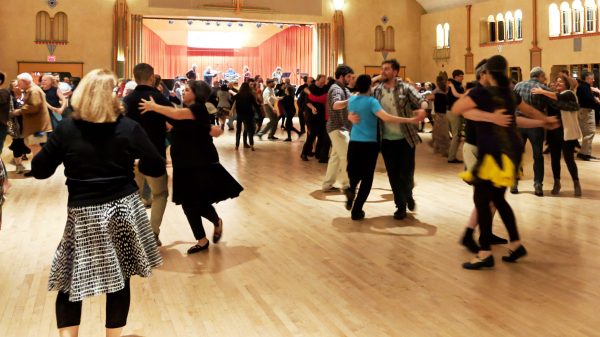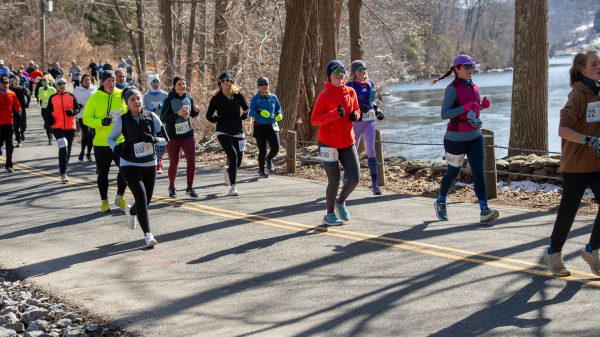KENT—Residents packed a Town Hall meeting room last Friday, Nov. 22, to hear more about a proposed and controversial town ordinance that calls for the installation of two traffic cameras in the village center with the aim of decreasing speeding in town.

The two-hour public hearing, held on Nov. 22, offered more information on traffic monitoring studies done earlier this year that showed a high number of instances where drivers have exceeded the posted speed limit near the town center along Route 7.
On Monday, Nov. 25, the selectmen, who had planned to take the issue to a town meeting vote on Dec. 6, postponed the meeting until Friday, Jan. 10, at 7 p.m. Residents will be asked to vote on the proposal by paper ballot. If approved the cameras could be installed by springtime.
“People said they thought it was too quick,” said First Selectman Marty Lindenmayer after changing the date. “Changing the time to 6 p.m., people who come up from the city didn’t think they could make it in time. It also conflicts with the Messiah Sing-in and we wanted to be respectful of that. A lot of people are impassioned about making their voices heard.”
The approximately 50 people who crammed into the meeting room, and two dozen more on Zoom, had plenty to say about the ordinance. Some claim cameras are simply not needed, while others say such a move is long overdue, especially in the downtown area that is crowded on weekends and home to most businesses.
“I’m concerned about the atmosphere cameras create,” said Lianna Gantt. “Are we turning our town into a speed trap? It’s embarrassing really. It makes me question why we’re doing this at all.”
Andy Ocif, a retired state trooper, said he’s not a big fan of cameras and said it may be time the town considers hiring a second resident trooper. Others in the audience suggested speed bumps could help with enforcement.
Resident Diane Kite cautioned that the town should be careful that the town doesn’t get the reputation that “Big Brother” is watching.
First Selectman Marty Lindenmayer said cameras would help increase safety, not only for drivers but for pedestrians. He said Kent School officials previously contacted his office in support of the ordinance.
“We are blessed that no one has been injured or hurt so far. I want to keep it that way,” Lindenmayer said.
Resident State Trooper Vicky Donohoe says she can sit on Route 7 any day and observe cars going over 50 miles per hour. She said one-third of the ticketed violators live in Kent. Because of speeding on the state routes, Donohoe said there is little time to monitor traffic in other town locations.

Earlier this year, the speed limit through the village center was dropped to 25 mph on both routes 7 and 341. As cars head south on Route 7 past Kent Greenhouse & Gardens, the speed limit was also decreased from 45 mph to 35 mph. As drivers come into town their speed is digitally displayed and posted signs remind them they are entering a 25 mph zone.
“Those signs make me slow down. It does work,” said resident Lee Ogden.
A number of residents, including Rufus de Rham, said it would be helpful first to see if cameras in other states make a difference. Data is limited in Connecticut as legislation giving municipalities the opportunity to install cameras was only passed a few years ago.
Residents in the town of Washington recently approved the installation of cameras.
“I’ve heard people say, ‘What are you doing in Kent?’” said de Rham. “I’d like to see updated data to see if people do get accustomed to lower speed limits.”
But resident Chris Garrity, who lives on North Main Street, said addressing the issue of speeding in Kent is long overdue and the number of speeders is increasing.
Traffic studies conducted by the town earlier this year in several locations on Route 7 near the village center, recorded more than 30,000 instances of drivers exceeding the posted speed limit by more than 10 mph.
Brandon Knox of Dacra Tech, whose company handles the processing of citations, addressed residents via Zoom. “There’s a lot of speeding going on in your town. There’s a mass amount of people going way faster than they should.”
The cameras detect and collect evidence of an alleged traffic violation by recording images that capture the time, date, plate and location of a motor vehicle that exceeds the speed limit by 10 miles per hour.
The alleged citation would have to be reviewed first by law enforcement personnel, perhaps Trooper Donohoe. A citation is then generated and sent to the vehicle owner. A fine of $50 plus a $15 processing fee would be imposed, with a small portion going to the company selected to generate and send out the infraction. A second offense would result in a $75 fine. There is also an appeal process for citizens.
Lindenmayer made clear that citations do not affect insurance rates or points on one’s license since no information is shared with other agencies.
Some in the audience questioned whether this was a way for the town to generate revenue, but Lindenmayer explained that any funds must be used for safety measures. He gave the examples of repainting crosswalks and paying state troopers for overtime.
And there are initial startup costs, he said. The purchase of two solar-generated cameras will cost $46,000.
Because so much data was presented during the hearing and for most, it was the first time seeing it, resident Lynn Harrington said the Dec. 6 meeting should be pushed back.
“There’s a lot of information to absorb and more information that is needed,” Harrington said. “This is critical for people to make an informed decision.”






































Brett
November 28, 2024 at 12:55 pm
The traffic study showed 30,000 instances of drivers exceeding the speed limit by 10+ MPH. Most of the speeding drivers are Kent residents. I can see why there is so much local opposition to the ticket machines.